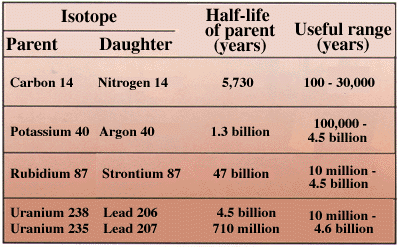Which Radioactive Isotope Is Used in Geological Dating
This rate however varies considerably among different radioactive isotopes. Another important atomic clock used for dating purposes is based on the radioactive decay of the isotope carbon-14 which has a half-life of 5730 years.

Radiometric Dating Methods Geology Modification For Lehman College Cuny
With radiocarbon dating the amount of the radioactive isotope carbon-14 is measured.

. A remarkable iron pillar dating to about AD. For example in the upper levels of our atmosphere cosmic rays strike nitrogen atoms and form a. If a geologist claims to be younger than his or her co-worker that is a relative age.
A technician of the US. Radiometric dating radioactive dating or radioisotope dating is a technique which is used to date materials such as rocks or carbon in which trace radioactive impurities were selectively incorporated when they were formed. If a radioactive isotope is said to have a half-life of 5000 years that means after 5000 years exactly half of it will have decayed from the parent isotope into the daughter isotopes.
Whereas relative dating arranges them in the geological order of their formation. 400 remains standing today in Delhi India. Note the great variations in their half-lives.
Absolute dating also called numerical dating arranges the historical remains in order of their ages. Compared to some of the other radioactive isotopes we have discussed carbon-14s half-life of 5730 years is. Simply stated each bed.
Then after another 5000 years half of the remaining parent isotope will have decayed. Absolute dating places events or rocks at a specific time. The most basic concept used in relative dating is the law of superposition.
Each original isotope called the parent gradually decays to form a new isotope called the daughter. Carbon-14 a radioactive isotope of carbon with a half-life of 5730 years is used to find the age of formerly living things through a process known as radiocarbon dating. These use radioactive minerals in rocks as geological clocks.
The atoms of some chemical elements have different forms called isotopes. The relative dating techniques are very effective when it comes to radioactive isotope or radiocarbon. As noted above the rate at which a given radioactive isotope decays into its daughter product is constant.
Stable 56 Fe is used for production of radioactive 55 Co with a half-life of about 18 h. Scientists know that a small amount of. 85 Isotopes Used as a Source of Radioactive Isotopes Help.
Archaeologists also use radioactive substances to determine the ages of fossils and other objects through a process called carbon dating. The method compares the abundance of a naturally occurring radioactive isotope within the material to the abundance of its decay products which. The theory behind carbon dating is fairly simple.
Below are some of the decay series that are commonly used in radiometric dating of geological samples. Carbon-14 14C or radiocarbon is a radioactive isotope of carbon with an atomic nucleus containing 6 protons and 8 neutrons. These are called relative and absolute dating techniques.
These break down over time in a process scientists call radioactive decay. This makes it ideal for dating much older rocks and. If a geologist claims to be 45 years old that is an absolute age.
Geological Survey uses a mass spectrometer to determine the proportions of neodymium isotopes contained in a sample of igneous rock. Its presence in organic materials is the basis of the radiocarbon dating method pioneered by Willard Libby and colleagues 1949 to date archaeological geological and hydrogeological samples.

Fossils Rocks And Time The Numeric Time Scale

Which Radioactive Isotope Is Used In Geological Dating Study Com

19 4 Isotopic Dating Methods Physical Geology First University Of Saskatchewan Edition
Comments
Post a Comment